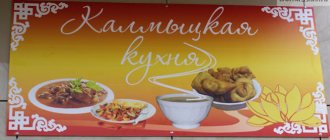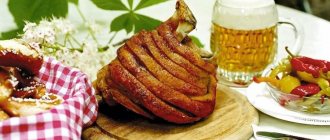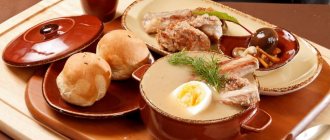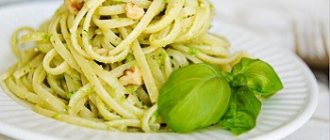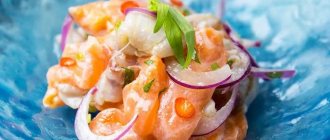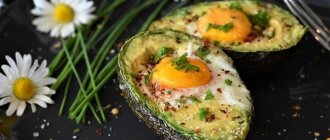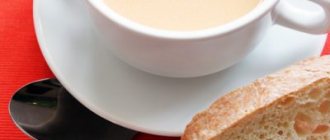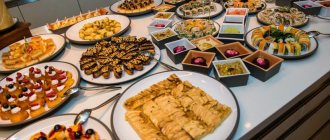Latvian cuisine has evolved over a long period of time under the influence of various national cuisines: Estonian, Lithuanian, Russian, German and Belarusian.
Latvian national cuisine is quite simple and satisfying , based on cereals, meat and fish products.
Over the course of a long time, recipes for traditional Latvian cuisine have undergone certain changes.
For example, the national Latvian dish of sour porridge (skabputra) with the addition of meat or lard has ceased to be popular among modern Latvians, and, one might say, has become a thing of the past.
Some national Latvian dishes, such as Jan cheese, are still often found on local tables.
The everyday food of Latvians is now more oriented towards
European cuisine . In everyday life, local residents usually eat cutlets, meat and fish, vegetable salads, and pork ribs. But during national Latvian holidays, traditional dishes of Latvian cuisine appear on the tables.
Features of national cuisine in Latvia
For Latvians, the main products are:
- Flour.
- Cereals.
- Potato.
- Dairy products.
- Peas.
- Beans.
- Other types of legumes.
- A wide variety of vegetables.
The country's location right on the Baltic Sea coast has made Latvians lovers of fish and seafood, although agricultural crops still occupy the first place in the diet.
What seems interesting to a Russian person is simply the incredible combination of products used in the preparation of some culinary masterpieces typical of Latvia.
Beer or bread soup with the addition of dried fruits, jelly made from black bread or rhubarb with whipped cream will also be very original for tourists. In general, for Latvians, for example, sweet, bread and milk soups are common, which cannot be said about other European residents.
Fish in national Latvian cuisine
The most favorite sea fish species in Latvia are herring, cod, and mackerel. If we talk about river fish, Latvians especially often cook carp, pike, perch and bream. Herring is very loved and revered in the country. It is grilled with vegetables, cooked over coals, and included in sandwiches. It is impossible to imagine Latvian cuisine without fish casseroles. Cod casserole (“Zivju pudiņš”) or herring (“Silju pudiņš”) is often prepared. Any Latvian restaurant serves salmon dishes.
The coast is dotted with many fish farms, where you can taste the freshest smoked lamprey, eel, cod or flounder.
Meat
The most popular type of meat is pork.
In ancient times, Latvians easily cooked and ate pig ears, snouts, and tails. Today you can also try them in many restaurants. They are served there like medieval, almost gourmet dishes.
Latvians often prepare aspic or baked pork knuckle. Lamb, veal, beef, and poultry are prepared, but they are an order of magnitude less popular than pork.
Vegetables and legumes
Latvians almost never do without vegetable dishes. The most popular are the simplest everyday options made from cabbage, onions and potatoes. In a real Latvian lunch, where potatoes and cabbage must be present, caraway seeds are also added.
Legumes are also not far behind. The most popular bean dish is served at Christmas. These are gray peas with speck. Almost all Riga restaurants prepare and serve this dish on Christmas Day. Even at Christmas markets it is always offered to visitors. In specialized restaurants that offer purely national cuisine, this dish can be ordered at any time of the year.
Bread
Every day on any Latvian table there is local rye bread and dishes based on it. Latvians use bread to make yoghurts, various desserts and even ice cream. Bread soups are common in this country. The stores sell not only delicious bread with dried fruits and nuts, but also light carrot bread, which surprises Russian tourists a lot.
Sweet
Latvians love sweets very much. In any supermarket you can find amazing buns with cottage cheese, poppy seeds, jam, and a lot of cakes.
Or you can go to a good restaurant and taste sweet bread soup with whipped cream.
Tsarnikava lampreys
The fishing village of Carnikava, located 30 kilometers northeast of Riga, is the birthplace of the national Latvian delicacy. And these are not sprats! And lamprey - it has been smoked and fried on coals here for three hundred years.
The image of this snake-shaped fish, which has neither scales nor fins, has become so firmly entrenched in the national culture that it is even depicted on the coat of arms of the Carnikava region.
Lamprey is a very fatty fish, it is caught from August to February at the mouth of the Gauja River. In the past, lamprey was served at the royal table. Catherine II especially loved her.
48 hours in Riga
Lamprey is delicious in all forms - hot smoked, cold smoked, or marinated. You don’t have to go to Tsarnikava to try this delicacy. You can taste lamprey at the Riga fish market or in the capital's restaurants serving national cuisine. Lamprey is also sold in supermarkets. The perfect pairing for it is a piece of the freshest Riga bread. However, lamprey is also good with white bread, butter, a slice of lemon and black olives.
In its finished form, the lamprey is prettier than in its original, natural state; Before marinating, fresh lamprey is fried
Posted by Taverna Grolle (@tavernagrolle) Jun 20, 2021 at 10:15 am PDT
The price, however, is steep: smoked will cost about 30 euros per kilogram. The best time for tastings is September, October and November.
In 1875, one of the first artificial fish breeding enterprises in Latvia was created in Carnikava. Every year, on the third Saturday of August, Lamprey Day is held in the village of Tsarnikava.
Beer in LatviaRiga
But we didn’t like beer in Latvia, no matter where you drank it, be it in the tourist center or on the outskirts of the city. You come in and pay 20 Euros for two glasses and snacks, but there is zero pleasure, neither from the taste and the drinking process itself, nor from the consequences.
So we tried beer in the center of old Riga, it’s not tasty, we think maybe there is something outside the old town in restaurants for locals... Ahh no.
So we scoured the entire Internet, found very positive reviews, even praising one beer store-restaurant (a bar based on a store, two in one), in the city center - Valmiermuizas (full name Valmiermuizas Alus tirgotava Riga), located at the address: Aristida Briana iela 9, Riga, LV-1001, Latvia. We stumbled into it, and it is located 3 kilometers from the old city of Riga, and in the end...
We tried different types of beer in the restaurant, but they all turned out to be bitter and watery. Unfiltered, also not tasty. After two glasses, my head was cracking at night.
Beer costs from 3.20 Euros per 0.5 liter. Snacks are about the same.
On the Internet, the cheeses, crackers and other snacks of this establishment were praised along with beer. We tried it! I liked the cheeses, but the beer croutons were disappointing due to too much butter.
And we barely finished the much advertised malt cookies, 1 Euro for a tiny bag, at home.
To avoid attacks, I’ll immediately make a reservation that this is only our personal opinion about beer in Latvia and the Valmiermuizas restaurant, maybe someone likes it.
PS The main tourist life in Riga is concentrated in the old town and its surroundings. There is also the largest number of cafes and restaurants for every taste and budget. So we recommend staying in Riga in the old town, or not far from it. Hotels, guest houses, hostels, etc. are better. The fact is that Riga is a popular tourist city, and there are many vacationers there at any time of the year.
Piparkukas
9 reasons to go to the Baltics in spring
Shaped like hearts, people and stars: these spiced cookies are a symbol of Christmas in Latvia. However, piparkukas (literally translated as “pepper cookies”) are prepared at any other time of the year. The base is flour, sugar, eggs and butter. But the main thing is the spices, including allspice, cloves, cardamom, dried ginger and cinnamon. The finished dough is rolled out into a layer about one millimeter thick and various figures are cut out from the dough. Bake cookies for 10-15 minutes.
Publication from Gingerbread? COOKIES? SUGAR ART (@olga.shperling_icing)Nov 1, 2021 at 3:53 PDT
The recipe for piparkukas is as practical as possible; these traditional cookies are easy to prepare at home. The main thing is not to skimp on spices: they are what give it such an interesting taste.
Traditional dishes of Latvian cuisine
It’s better to start getting acquainted with Latvian cuisine with putra.
This dish has no analogues in the whole world. It is prepared from fish, meat, cereals and potatoes. First, all the ingredients need to be cooked separately, then put into one container, add cottage cheese and kefir and leave for a day in a cold place.
The next day, the unusual dish can be served. Several centuries ago, this dish was one of the favorites among peasants. Today the dish is undeservedly forgotten - you can try putra only in a few restaurants.
Tourists might like beer soup. You can repeat the dish at home. Mix half a liter of beer with two tablespoons of caraway seeds, bring to a boil and pour the egg, ground with 100 grams of sugar, into the pan.
Remove the dish from the heat at the first signs of boiling. Beer soup is usually served with croutons and cheese.
When you mention semolina, many people think of cooled porridge with lumps. Latvians have come up with a way to cook this cereal very tasty.
To prepare the dish, which in the Baltic country is known as “buberts,” you need to beat the yolks and whites of two eggs separately.
The whites are mixed with salt, the yolks with half a tablespoon of sugar. Bring 500 ml of milk to a boil, pour semolina over it, stirring constantly.
Place on the fire again and cook for about five more minutes. After this, whipped whites and yolks are added to the future buberts.
The finished food is transferred to a deep plate. The porridge is generously poured with cranberry sauce and then the finishing touch is added - a generous sprinkling of chocolate on top. The dish must be consumed hot.
Traditional Latvian dishes
Several centuries ago, peasants considered boiled potatoes with kefir or milk their traditional food. If possible, meat appeared on the dinner table. Basically, in addition to potatoes, milk products, rye bread and meat, pickled or pickled vegetables were present during meals. And since salt was an expensive pleasure for local residents, they tried to reduce it in dishes or replace it with garlic, mustard and cumin.
If you look at historical reports, you can see that the table in Latvia was always rich in cold appetizers and salads, but there was no time to prepare hot first and second courses. Of course, there are plenty of recipes for cold soups in Latvia, but you must admit, sometimes you want tasty and hot borscht or soup.
Restaurants in Latvia offer a large selection of traditional Latvian dishes. The menu has many fish dishes: herring, lamprey, mackerel. Meat dishes are often prepared from pork. Side dishes include various cereals, beans and cabbage. For starters, milk, pea, and bread soups are offered. An obligatory addition to any type of food is Latvian bread made from rye flour. Latvians simply love sweet dishes. Desserts in Latvia are full of variety. Rice pudding, vecriga, piparkukas, bubert – none of these desserts will leave you indifferent.
The list of traditional Latvian dishes includes:
- pies with bacon;
- putra - porridge prepared with the addition of kefir or curdled milk, lard, fish or smoked meats and vegetables;
- sklandrausis is a rye flour pie, the filling of which consists of potatoes, carrots, sour cream and eggs;
- gray peas cooked with bacon;
- peasant breakfast - finely chopped, fried potatoes and meat, baked in eggs with sour cream.
Categories
- Type
- Holidays
- Simple
- Warm
- Lenten
- Fruit
- Exotic
- By ingredient
- Vegetables
- Brassicas
- Carrot
- Beans
- Mushroom
- Meat
- Chicken
- Fish
- Crab
- Cheese
- Ham
- With titles
- Olivie
- Mimosa
- Herring under a fur coat
- Greek
- Caesar
- The vinaigrette
- All salads
- Spreads
Apple pie
The apple tree is a widespread tree in Latvian latitudes. Therefore, it is not at all surprising that many desserts are prepared here using such fruits.
The national dish of Latvia, apple pie, requires the use of the following ingredients:
- Flour – 2 cups.
- Apples cut into small cubes – 500 grams.
- Butter – 300 grams.
- Eggs – 4 pieces.
- Sugar - one glass.
- Baking soda - dessert spoon.
Melt the butter in a saucepan. Add egg yolks ground with sugar. Mix the ingredients well. Flour and soda are poured into the container. The products continue to be mixed with a spoon until a consistency resembling thick sour cream is formed. Chopped apples are added to the dough, followed by beaten egg whites.
Grease a baking sheet with oil. The surface is sprinkled with a thin layer of breadcrumbs. The prepared dough is poured here. Preheat the oven to a temperature of 200 oC. The pie is baked for 30-40 minutes.
Bread soup
The dish is a traditional Latvian dessert. The food is served cold. The base is rye bread, which looks quite unusual.
Ingredients for cooking:
- Rye bread without yeast – 150 grams.
- Boiled water – 2 glasses.
- Dried fruits – 150 grams.
- Medium fat cream – 60 ml.
- Cranberries – 50 grams.
- Sugar – 4 tablespoons.
- Cinnamon and vanilla - a small pinch.
- Cookies - to taste.
The bread is cut into slices, after which it is laid in an even layer over the entire area of a baking sheet, previously covered with baking paper. Preheat the oven to 160 °C. The bread is fried for half an hour. Then the croutons are removed from the oven and cooled. The product is poured with water and left to soak for 35-40 minutes.
Wash dried fruits using a colander and then dry. The soggy bread is ground into pulp. Half the norm of sugar and cinnamon are added here. The mixture is combined with dried fruits. The semi-liquid composition is sent to the stove. Boil the soup over medium heat for 10 minutes. After cooling, place the dish in the refrigerator for several hours.
Take cranberries, rinse under running water and crush with a spoon. The berries are ground through a sieve. The resulting juice with pulp particles is added to the dish. Whisk the cream together with the remaining sugar and vanilla and then stir into the soup. The top of the dish is sprinkled with crushed cookies.
Specifics of Latvian cuisine
The country's culinary traditions have developed due to the influence of several gastronomic trends. The first concerns the traditions of the German part of the population. It was these people who taught Latvians to eat all kinds of marinades, smoked meats, pickled vegetables, and pickles. Another direction was formed among local peasants, whose daily diet consisted of dairy products, grains, meat and potatoes. The combination of such influences is responsible for the formation of modern Latvian cuisine.
The coastal location of the state's territories has given rise to a wide range of fish dishes. Most recipes involve the use of seafood, in particular cod, herring, herring, and mackerel. Almost every Latvian restaurant offers dishes with salmon.
Latvian cuisine looks incomplete without local rye bread, which is used to organize any feast, and is considered a national treasure. The product is even used in soups, desserts, and yoghurts.
As you can see, Latvian national cuisine has many specific features. Let's not dwell on the traditions of the region. Let's move on to looking at the names, recipes and tips for preparing local dishes.
Houses
Category: Desserts Cakes
BIEZPIENA MAJINAS [biezpiena mainas] - Cottage Cheese Houses. Latvians love cottage cheese very much, and therefore many Latvian dishes are prepared from it. The base of the cottage cheese house consists of three (square or rectangular) cookies, forming a “triangle”, which is filled with sweet curd mass. This dish is very popular in Latvia, especially among children. Houses are especially often found on holiday tables, or just for tea. The taste is so delicate that the houses imperceptibly disappear and disappear.

